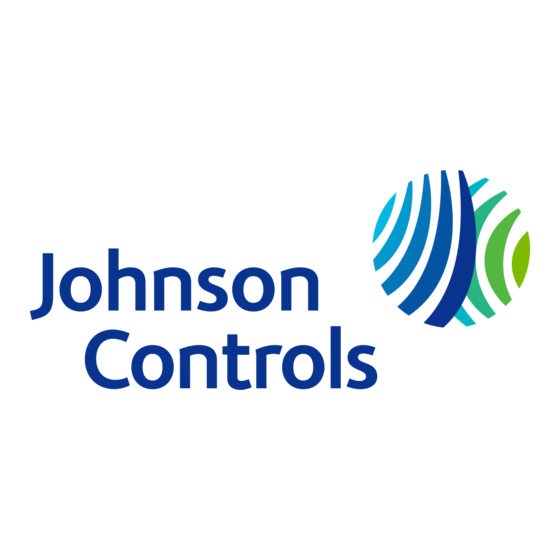Table of Contents
Advertisement
Quick Links
7351J Very Intelligent Early Warning (VIEW)
© 2002 Johnson Controls, Inc.
Code No. LIT-408092
All manuals and user guides at all-guides.com
Laser Smoke Detector
Technical Bulletin
Issue Date
November 15, 2002
www.johnsoncontrols.com
2
2
3
5
5
6
6
7
7
10
12
13
1
Advertisement
Table of Contents

Subscribe to Our Youtube Channel
Summary of Contents for Johnson Controls Metasys VIEW 7351J
-
Page 1: Table Of Contents
7351J Very Intelligent Early Warning (VIEW) Laser Smoke Detector Introduction Prerequisites General Description Installation Procedures Pre-Installation Guidelines Detector Installation Procedure Limiting Dust Exposure Testing and Maintenance Procedures Testing Maintenance Laser Safety Information Limitations © 2002 Johnson Controls, Inc. Code No. LIT-408092 www.johnsoncontrols.com... -
Page 2: Introduction
Johnson Controls 7351J VIEW laser detector. This detector is manufactured by System Sensor for use with Johnson Controls fire alarm systems. If you install this detector for someone else to use, leave a copy of this document with the user. -
Page 3: General Description
All manuals and user guides at all-guides.com The 7351J is a plug-in type smoke sensor that has a laser-based General photoelectronic sensing chamber. Using FlashScan® communication Description protocol on the Signaling Line Circuit (SLC), the sensor uses analog-addressable communications to transmit smoke density and other information to the central panel. - Page 4 All manuals and user guides at all-guides.com Table 1: Technical Specifications 15 to 32 VDC Operating Voltage Range 230 microamperes at 24 VDC (no Maximum Standby Current communication) Maximum Average Standby 330 microamperes at 24 VDC (one communication every 5 seconds with LED blink Current enabled) Maximum Alarm Current...
-
Page 5: Installation Procedures
All manuals and user guides at all-guides.com Installation Procedures This section contains information for Johnson Controls 7351J laser smoke Pre-Installation detectors. It includes guidelines for spacing the detectors and for installing Guidelines wiring. WARNING: Risk of Personal Injury. Use of control, adjustments, or performance of procedures other than those specified in this technical bulletin may result in hazardous radiation exposure. -
Page 6: Detector Installation Procedure
All manuals and user guides at all-guides.com Detector Installation CAUTION: Risk of Equipment Damage. Installation with power on may damage the detector and the fire alarm control Procedure panel. Always remove power from the SLC communication line before installing detectors. Use the following procedure to install a detector: 1. -
Page 7: Testing And Maintenance Procedures
• the SLC connections at the control panel 2. If the LEDs on the detector still do not blink, return the detector to Johnson Controls for service. After You Test After you set a detector into alarm by one of the following test methods... - Page 8 All manuals and user guides at all-guides.com Testing Frequency The sensitivity and function of each detector must be tested after the initial installation and periodically thereafter. Refer to the NFPA 72 National Fire Alarm Code for the required frequency. Check with your local authority for the requirements in your area.
- Page 9 All manuals and user guides at all-guides.com Four Tests Functional Test You can test the functioning of this detector using a test magnet (M02-04-01). This magnet electronically simulates smoke in the sensing chamber, testing the detector electronics and connections to the control panel.
-
Page 10: Maintenance
At the end of 90 days, a Johnson Controls branch representative (or end user trained by a Johnson Controls branch representative), should inspect the results of the test by reviewing the data collected in the history file of the system control panel or the record on the system’s printer. - Page 11 All manuals and user guides at all-guides.com When Testing and When maintenance and all subsequent testing are complete: Maintenance Are 1. Enable the system functions previously disabled for maintenance. Complete 2. Notify the authorities that the system is back in service. Detector Cleaning Use this procedure to clean the detector.
-
Page 12: Laser Safety Information
All manuals and user guides at all-guides.com Detector Cover RF Shield Cover Removal Tabs Chamber Cover Smoke Sensing Chamber Cover/Screen Smoke Sensing Photo Diode Chamber Base Spring Contact Circuit Board To Bug Screen Contacts to Mounting Brackets Smoke Detector Base lpx751_2 Figure 4: Screen Assembly and Sensing Chamber This smoke detector does not produce any hazardous laser radiation. -
Page 13: Limitations
All manuals and user guides at all-guides.com This smoke detector is designed to activate and initiate emergency action Limitations but does so only when used with other equipment. This detector is designed for installation in accordance with NFPA Standard 72 National Fire Alarm Code, or equivalent codes and standards applicable to country of installation.






Need help?
Do you have a question about the Metasys VIEW 7351J and is the answer not in the manual?
Questions and answers